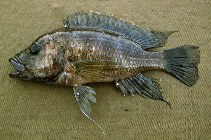| Family: |
Cichlidae (Cichlids), subfamily: Pseudocrenilabrinae |
| Max. size: |
21.5 cm TL (male/unsexed) |
| Environment: |
benthopelagic; freshwater; pH range: 7.40000009536743 - 8.39999961853027; dH range: 7 - 30 |
| Distribution: |
Africa: northern part of Lake Tanganyika (Ref. 4983). |
| Diagnosis: |
Dorsal spines (total): 16-18; Dorsal soft rays (total): 8-10; Anal spines: 3-3; Anal soft rays: 7-8. Body deep and moderately compressed (Ref. 57075). Presence of a thick sensory canal on the six infraorbitals, with large openings that are widely separated from each other (Ref. 57075). Unicuspid outer and inner teeth on both jaws; outer teeth arranged in a single regular row; inner teeth smaller than outer teeth, arranged in three to six irregular rows on anterior part of upper jaw (Ref. 57075). Presence of 2 scale rows between upper and lower lateral lines (Ref. 57075). Scales ctenoid on flank; cheek scaled; dorsal and anal fins with scales at base; caudal fin with small scales anteriorly on fin membranes between rays; paired fins without scales (Ref. 57075). Upper lateral line high on body with 21-25 scales, lower lateral line running along body axis with 11-16 scales, two pored scales anteriorly on caudal fin (Ref. 57075). |
| Biology: |
The mouth is very protrusable which favor the idea of a planktonic diet (Ref. 7343). |
| IUCN Red List Status: |
Least Concern (LC); Date assessed: 31 January 2006 Ref. (130435)
|
| Threat to humans: |
harmless |
Source and more info: www.fishbase.org. For personal, classroom, and other internal use only. Not for publication.

